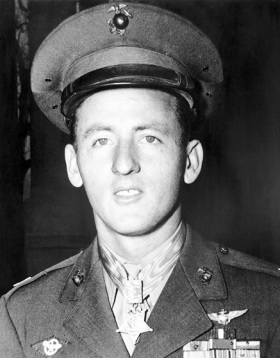The F4F Wildcat
When the US Navy and US Marine Corps (USMC) went to war in December 1941, their primary carrier fighter was the tubby Wildcat, the first of Grumman’s famous “cats,” built by the company. Despite the F4F’s inferior performance compared to the Japanese Zero-sen, its sturdy construction and ample armament allowed the Wildcat pilots to hold their own against some of the world’s best naval aviators during air battles between the US Navy/USMC and the IJN.
Jefferson DeBlanc, USMC F4F Wildcat “ace in a day” pilot
A claim confirmed by the action on Jan. 31, 1943, that saw 2Lt Jefferson DeBlanc, a USMC pilot from VMF-112, argue two Type 0 Observation seaplanes and three Zero-sens shot down over Vella Gulf while protecting a flight of SBD dive-bombers. An “ace in a day” feat that earned him the Medal of Honor.
In his book F4F Wildcat South Pacific 1942–43, Edward M. Young explains that at 1500 hours on that day, VMF–112 sent off two divisions of Wildcats to escort SBDs and TBFs on a mission to attack Japanese shipping in the Vella Gulf, which is located between the Kolombangara Islands and Vella Lavella Islands to the north of Guadalcanal. Six aircraft took off in two flights, with two aircraft climbing to offer high cover and DeBlanc leading four as close escort while two F4Fs were forced to turn back.
The Type 0 Observation seaplanes attacked the dive-bombers as they were finishing their runs and regrouping for the return flight. DeBlanc observed two “Petes” flying in trail and closing in on the SBDs. DeBlanc saw two “Petes,” flying in trail, closing in on the SBDs. With his wingman, SSgt. James Feliton, providing cover, DeBlanc attacked the trailing floatplane, coming in from the “six o’clock” position and setting it on fire. DeBlanc then went after the lead “Pete,” again from behind. After his initial burst, he noticed flames trailing from his target. The floatplane then turned slowly to the right, climbed slowly, and exploded.
Medal of Honor
DeBlanc and Feliton stayed with the SBDs, fighting off Zero-sens strikes even though they were running low on fuel. DeBlanc stated that before having to bail out his severely damaged fighter, three of the fighters were shot down. Feliton had to use his parachute as well. After thirteen days, both DeBlanc and Feliton made their way back to Guadalcanal with the help of coastwatchers and the Solomon Islands police force. DeBlanc received the Medal of Honor for his actions.
F4F Wildcat South Pacific 1942–43 is published by Osprey Publishing and is available to order here.
Photo by Gareth Hector via Osprey and NARA

familiar with the Wildcat. Unfazed by this, DeBlanc claimed two “Betty” bombers
shot down on Nov. 12 on only his second combat mission. On Jan. 31, he claimed
five aircraft destroyed while defending USMC SBDs and TBFs. The latter feat earned DeBlanc the Medal of Honor. (DM-SD-03-09572, NARA)

